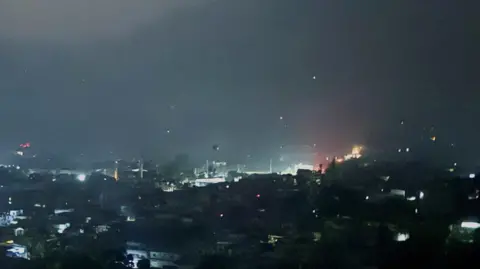
[ad_1]
 Reuters
ReutersTwo weeks after a deadly attack on tourists in Kashmir, India launched a series of strikes at Pakistan and Kashmir locations.
The Indian Ministry of Defense said that the strikes – which bears the “Sindor Operation” – were part of the “commitment” to the responsibility of the April 22 attack, which left 25 Indian and Nepalese’s “official.”
But Pakistan, which denied any involvement in the attack last month, described the strikes as “unjustified”, as Prime Minister Sharif Sharif said that “the act of heinous aggression will not pass without an amount.”
The Pakistan Army says it has shot down five Indian planes and drone. India has not yet responded to these claims.
The Pakistani military spokesman, Lieutenant General Sherif Sharif Chaudhry, said at least 26 people were killed and 46 were wounded. The India Army said that at least 15 civilians were killed, and 43 were wounded by Pakistani bombing on its side of the realistic borders.
Where did India hit?
Delhi said in the early hours of Wednesday morning that nine different sites were targeted in Kashmir and Pakistan.
She said that these sites were “terrorist infrastructure” – places “planned and attacks.”
She emphasized that she did not reach any Pakistani military facilities, saying that “her actions have been focused, measured and not related to their nature.”
In the aftermath of the initial attacks, Pakistan said that three different areas were wounded: Muzaffar Abad and Kotley in Kashmir Pakistan, and Bahwalbur in the Pakistan Punjab province. Pakistan’s military spokesman, Lieutenant General Ahid Sharif, later said that six sites had been beaten.
In the early hours of Wednesday, Pakistani Defense Minister Khawaja Asif Jiouf told the civilian defense, adding that the demand of India “targeting terrorist camps” was wrong.
Why did India launched the attack?
The strikes come after weeks of increased tension between nuclear armed neighbors on fire in the beginner town of Pahalgam.
The April 22 attack by a group of militants witnessed the killing of 26 people, as the survivors said that the militants were fleeing the Hindu men.
This was the worst attack on civilians in the region in two decades, and the first major attack on civilians since India was canceled of Article 370, which was granted Kashmir almost independent in 2019.
In the wake of the decision, the region witnessed protests, but also witnessed a significant increase and increase in the number of tourists visiting the region.
The killings sparked widespread anger in India, where Prime Minister Narendra Modi said that the country would hunt the suspects “until the ends of the earth” and that those who planned and implemented it “will punish their imagination.”
However, India has not called any group suspected of the attack in Paalgam and is still unclear than doing it.
But the Indian police claimed that two attackers were Pakistani citizens, as Delhi accused Pakistan of supporting the militants – a charge that denies Islamabad. It says it has nothing to do with the April 22 attacks.
In the two weeks since then, both sides have taken measures against each other-including the expulsion of diplomats, and the suspension of visas and closing border crossings.
But many expected to escalate to a type of cross -border strike – as it appears after the Polama attacks that left 40 almost Indian military personnel in 2019.
Why Kashmir Flash point between India and Pakistan?
Kashmir has been completely called by India and Pakistan, but it has only managed it since it was divided after independence from Britain in 1947.
The two countries have fought two wars on it.
But recently, it was attacked by the militants who brought the two countries to the brink of the abyss. Kashmir by the Indian has witnessed an armed rebellion against Indian rule since 1989, as the militants targeted both security forces and civilians.
In 2016, after 19 Indian soldiers were killed in URI, India launched “surgical strikes” through the control line – the realistic borders between India and Pakistan – targeting armed bases.
In 2019, the bombing of Poloa, which left 40 semi -Indian military personnel, has pushed air strikes deep in cut – the first such action in Pakistan since 1971 – which sparked reprisal raids.
Not escalating, but the wider world remains awake at the risk of what could happen if that happens. Attempts by various nations and diplomats all over the world were made to prevent this.
Soon the United Nations President Antonio Guterres called for the “maximum self -control” – a feeling that the European Union and many countries, including Bangladesh.
British Prime Minister Kiir Starmer urged the “dialogue” and “canceling the escalation.”
US President Donald Trump – who was one of the first to respond – told the White House correspondents that he hoped the fighting would “end very quickly.” Meanwhile, US Secretary of State Marco Rubio said he was closely monitoring developments.

